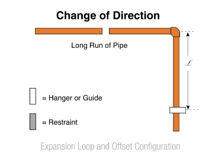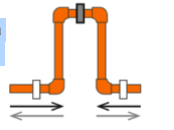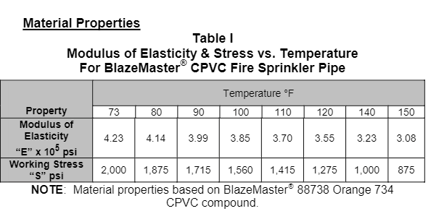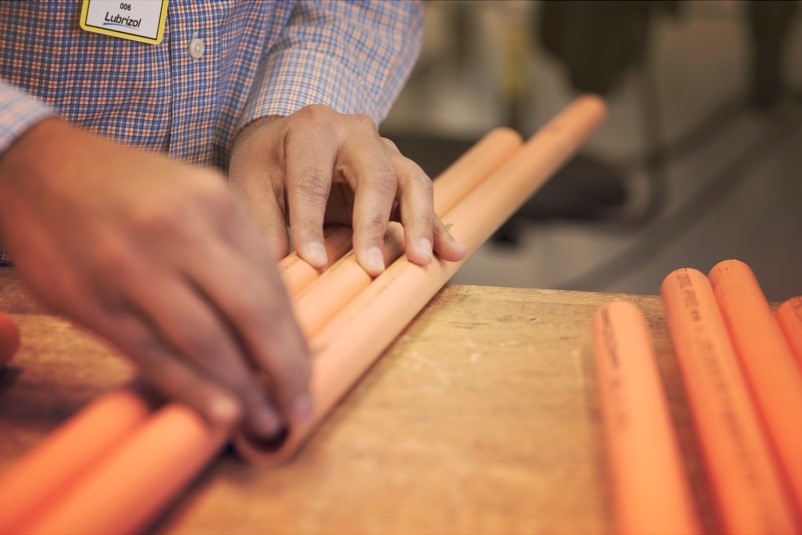4 Steps for Designing a BlazeMaster® Fire Sprinkler System to Allow Expansion and Contraction
Like other piping materials, BlazeMaster CPVC expands as temperatures rise and contracts as temperatures fall. That means that the pipe will get longer in warm temperatures and shorter when it’s colder, which creates stress on the pipe that can lead to premature reliability issues.
For example, a pipe constrained at both ends will be stressed as it expands when temperatures rise. Eventually, the pipe may crack or break, creating a leak.
Expansion and contraction is mainly a concern in unconditioned spaces, such as attics. In conditioned spaces, there is minimal change in temperature and as a result little expansion and contraction. But it is important to keep expansion and contraction in mind when installing in very hot or cold weather before the HVAC system is operational. In these situations, there will be an initial expansion or contraction of the system.
The good news: It’s relatively easy to avoid these problems by designing the fire protection system to compensate for expansion and contraction. Here’s a four-step process:
1. Determine how much a pipe will expand or contract
The coefficient of thermal expansion (in./in.°F) describes how much linear expansion will result from every degree of temperature change. For BlazeMaster CPVC, the coefficient of linear expansion is: (0.0000340 in./in/°F (0.000061 cm/cm/°C) and linear expansion is the same for all pipe diameters.
Multiply the coefficient of thermal expansion by two factors:
- Length of pipe run. This is important to know, because pipe will expand or contract more as the run of pipe gets longer.
- Temperature change. Use the temperature the fire sprinkler system will be exposed to through its service life.
Here’s the formula to use:
∆L = Lp C ∆T
∆L – Change in length of pipe due to change in temperature (in.)
Lp – Length of pipe (in.)
C – Coefficient of thermal expansion (in./in./oF)
∆T – Change in temperature (oF)
You can find detailed charts on thermal expansion in inches and centimeters on our specifications page. In addition, you can download our free Thermal Expansion Calculator to help you better understand the linear expansion of BlazeMaster CPVC and design around compression stress issues.
2. Design to Reduce Stress

In most cases, changes in direction of the pipe run (Figure 1) will alleviate temperature-related stresses on CPVC pipe. The elbow and adjoining pipe at the end of a pipe run allows for enough movement. If the adjoining pipe is long enough, thermal expansion and contraction can be accounted for by placing a hanger or guide a defined distance away from the elbow.
In some situations, expansion loops or offsets may be required when installing long, straight runs of pipe.
Expansion Loop

As shown in Figure 2, an expansion loop creates a U shape. The opening of the U narrows for expansion and widens for contraction.
- Configure pipe into U shape with center restrained with a bracket.
- Use hangers or guides to hang each side of the pipe coming into the U.
Expansion Offset
This technique should be used when designing the layout around fixed structures (Figure 3). As temperatures rise, the top and bottom elbows will flex inward. In lower temperatures, the vertical pipe will flex outward.
- Place at the center of a pipe run.
- Use hangers or guides to set each pipe run.
3. Calculate Loop Length
An effective design using these deflections must address factors such as:
- Working stress – the maximum amount of stress the pipe and fittings can handle when in use
- Modulus of elasticity – a measure of pipe stiffness
- Outer pipe diameter – these measure affects the ability of the pipe to deflect stress.
These factors are essential to calculating loop length. Use this equation:
L = (3 ED (∆L))/2S
L – Loop length
E – Modulus of elasticity at maximum temperature (psi or kPa)
D – Outside diameter of pipe (in. or cm.)
∆L – Change in length due to change in temperature (in. or cm.)
S – Working stress at maximum temperature (psi or kPa)

4. Follow Best Practices
When designing the system:
- Leave adequate spacing (the loop length) between elbows and hangers/restraints.
- Construct expansion loops with straight pipe and 90° elbows that are joined with solvent cement.
- Avoid restricting natural movement of the pipe in the direction of the expansion and contraction.
- Do not butt-up elbows against studs, which restricts their movement.
- Refer to local codes and the manufacturer’s instructions when designing for thermal expansion.
With this process, you can ensure the fire protection system to flex as needed to accommodate thermal expansion and contraction.
Download our  to help you though this process. As always, if you have questions about upcoming projects – repairs, cut-ins and anything else – technical
to help you though this process. As always, if you have questions about upcoming projects – repairs, cut-ins and anything else – technical  .
.


